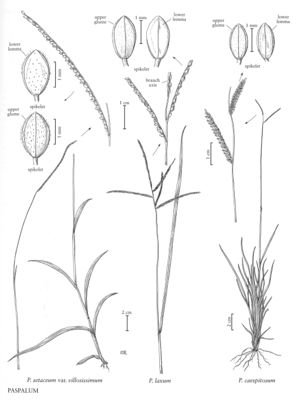Paspalum caespitosum
Plants perennial; cespitose. Culms 20-60 cm, erect, base swollen, bulblike; cataphylls pubescent; nodes sparsely pubescent or glabrous. Sheaths pubescent or glabrous; ligules 0.2-0.4 mm; blades to 25 cm long, 1.9-6.2 mm wide, flat, glabrous, pubescent behind the ligules, margins scabrous, often ciliate basally. Panicles terminal, with 2-5 (8) racemosely arranged branches; branches 0.9-4.4 cm, divergent to spreading, terminating in a spikelet; branch axes 0.2-0.5 mm wide, narrowly winged. Spikelets 1.3-2 mm long, 0.7-1 mm wide, paired (rarely appearing solitary as a result of aborted spikelets), imbricate, appressed to the branch axes, elliptic. Lower glumes absent; upper glumes and lower lemmas glabrous or sparsely and shortly pubescent basally or around the margins, 5-veined, margins entire; lower lemmas lacking ribs over the veins; upper florets 1.3-1.8 mm, stramineous to golden brown. Caryopses 1.2-1.4 mm, ellipsoid, amber. 2n = 40.
Distribution
Puerto Rico, Virgin Islands, Fla., Ala.
Discussion
Paspalum caespitosum grows in hammocks and sandy pinelands. It is native in southern Alabama, Florida, the West Indies, Mexico, and Central America.
Selected References
None.
Lower Taxa
"decumbent" is not a number.
